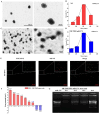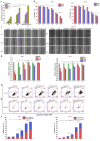Nanoplatelets modified with RVG for targeted delivery of miR-375 and temozolomide to enhance gliomas therapy
- PMID: 39402578
- PMCID: PMC11476726
- DOI: 10.1186/s12951-024-02895-6
Nanoplatelets modified with RVG for targeted delivery of miR-375 and temozolomide to enhance gliomas therapy
Abstract
Gliomas are one of the most frequent primary brain tumors and pose a serious threat to people's lives and health. Platelets, a crucial component of blood, have been applied as drug delivery carriers for disease diagnosis and treatment. In this study, we designed engineered nanoplatelets for targeted delivery of therapeutic miR-375 and temozolomide (TMZ, a first-line glioma treatment agent) to enhance glioma therapy. Nanoplatelets were prepared through mild ultrasound, TMZ and miR-375 were co-loaded through ultrasound and electrostatic interactions, respectively, to combine chemotherapy with gene therapy against glioma. To improve the blood brain barrier (BBB) crossing efficiency and glioma targeting ability, the nanoplatelets were modified with central nervous system-specific rabies viral glycoprotein peptide (RVG) through thiol-maleimide click reaction. The RVG modified nanoplatelets co-loaded TMZ and miR-375 (NR/TMZ/miR-375) not only inherited the good stability and remarkable biocompatibility of platelets, but also promoted the cellular uptake and penetration of glioma tissues, and effectively induced cell apoptosis to enhance the therapeutic effect of drugs. In vivo studies showed that NR/TMZ/miR-375 significantly increased the circulation time of TMZ, and exhibited superior combined antitumor effects. In summary, this multifunctional 'natural' nanodrug delivery system provides a potent, scalable, and safety approach for platelet-based combined cancer chemotherapy and gene therapy.
Keywords: Gliomas; MiR-375; Nanoplatelets; TMZ; Targeted drug delivery.
© 2024. The Author(s).
Conflict of interest statement
The authors declare no competing interests.
Figures








Similar articles
-
Development of transferrin-modified poly(lactic-co-glycolic acid) nanoparticles for glioma therapy.Anticancer Drugs. 2019 Jul;30(6):604-610. doi: 10.1097/CAD.0000000000000754. Anticancer Drugs. 2019. PMID: 30855310
-
MiR-181b-5p modulates chemosensitivity of glioma cells to temozolomide by targeting Bcl-2.Biomed Pharmacother. 2019 Jan;109:2192-2202. doi: 10.1016/j.biopha.2018.11.074. Epub 2018 Nov 27. Biomed Pharmacother. 2019. PMID: 30551476
-
MSC-AS1 knockdown inhibits cell growth and temozolomide resistance by regulating miR-373-3p/CPEB4 axis in glioma through PI3K/Akt pathway.Mol Cell Biochem. 2021 Feb;476(2):699-713. doi: 10.1007/s11010-020-03937-x. Epub 2020 Oct 26. Mol Cell Biochem. 2021. PMID: 33106913 Free PMC article.
-
Progress in research and development of temozolomide brain-targeted preparations: a review.J Drug Target. 2023 Feb;31(2):119-133. doi: 10.1080/1061186X.2022.2119243. Epub 2022 Sep 7. J Drug Target. 2023. PMID: 36039767 Review.
-
Exosomes as nature's nano carriers: Promising drug delivery tools and targeted therapy for glioma.Biomed Pharmacother. 2025 Jan;182:117754. doi: 10.1016/j.biopha.2024.117754. Epub 2024 Dec 27. Biomed Pharmacother. 2025. PMID: 39731936 Review.
Cited by
-
Combined Strategies for Nanodrugs Noninvasively Overcoming the Blood-Brain Barrier and Actively Targeting Glioma Lesions.Biomater Res. 2025 Feb 5;29:0133. doi: 10.34133/bmr.0133. eCollection 2025. Biomater Res. 2025. PMID: 39911305 Free PMC article. Review.
-
GLUT3 enhances chemosensitivity in glioblastoma by transporting temozolomide and capecitabine.Cell Death Discov. 2025 Aug 14;11(1):382. doi: 10.1038/s41420-025-02664-w. Cell Death Discov. 2025. PMID: 40813374 Free PMC article.
References
-
- Madani F, Esnaashari SS, Webster TJ, Khosravani M, Adabi M. Polymeric nanoparticles for drug delivery in glioblastoma: state of the art and future perspectives. J Controlled Release. 2022;349:649–61. - PubMed
-
- Sousa F. Emerging cytokine delivery with nanomedicine for brain cancer treatment. Expert Opin Drug Deliv. 2024;21:513–6. - PubMed
-
- Wang J, Liu Y, Morsch M, Lu Y, Shangguan P, Han L, et al. Brain-targeted aggregation-induced-emission nanoparticles with near-infrared imaging at 1550 nm boosts orthotopic glioblastoma theranostics. Adv Mater. 2022;34:2106082. - PubMed
MeSH terms
Substances
Grants and funding
LinkOut - more resources
Full Text Sources
Medical

